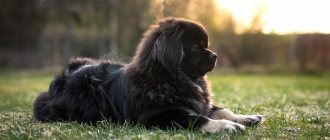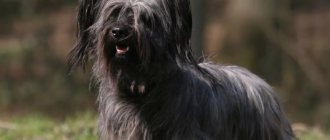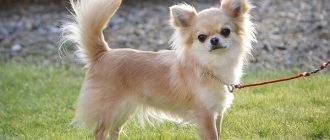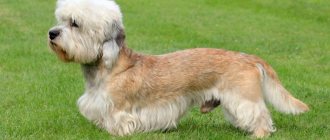Brief characteristics of the dog
- Other possible dog names: Tibetan Terrier, Lhasa Terrier, Dhoki Apso, Tsang Apso, Tibetan Apso.
- Adult height: 30-40 cm.
- Weight: 8-14 kg.
- Characteristic color: golden, black, white, fawn, smoky, cream.
- Coat length: thick, long, fine.
- Life expectancy: 12-15 years.
- Advantages of the breed: friendly, intelligent, balanced, a wonderful companion and watchman.
- Breed Difficulties: Grooming required, independent.
- Average price: a Tibetan terrier with a pedigree costs from $500.
Description of the breed
Description of the breed: medium-sized compact dog, muscular, with strong bones and long thick hair. When the Tibetan Terrier is calm and static, it may seem that it is a dog without a tail, it just has a fountain of fur on its back. Dogs have dark eyes and a black nose. The forehead is convex, the ears are drooping and well-furred. The tail is set high, with good thick hair. Rare wool is a waste. In a good, cheerful mood, the dog throws its tail over its back. Tibetan Terriers with too high paws and a long back (in general, with a more elongated format) are not allowed for exhibitions.
Scissor bite. Males can always be easily distinguished from females by their more powerful build and thicker, fluffier coat. Puppies of this breed cost from $500. Only mestizos can have a lower price. You can apply for puppies at the Barry Burri kennel, as well as Talisman Tibet and Goldie Anshula.
Size and weight
According to the breed standard, the height of a male at the withers is 38-41 cm, that of a female is 36-39 cm. Weight does not depend on gender, the upper threshold is 14 kg, the lower threshold is 8 kg.
Height below the minimum is a disqualifying fault for the Lhasa Terrier. A size that is too small may find its buyer, but such a dog will not be allowed into the exhibition.
Colors and coat care
The modern standard of the Tibetan Terrier assumes the following colors:
- plain uniform;
- bicolors;
- tricolors;
- pibold.
Peebold is a white color with uneven, pronounced spots of any other color. Lhasa apsos are very beautiful with their golden color.
Coat care includes mandatory daily combing. If the dog is dirty, you can wash it, but only the hair is treated with shampoo: detergents should not reach the skin, as this can cause allergies.
The Lhasa Apso does not shed.
After washing, you need to dry the dog well, wrap it in a towel and dry it. You cannot use a hairdryer, it will ruin the wool. After walks in damp rainy weather, the dog also needs to be dried. You can wear overalls on your dog in dusty winds and rain.
Grooming of the Tibetan Terrier should only be carried out by a specialist. An owner who has learned grooming skills can also become one. How to cut a dog's hair depends on whether it is being exhibited or whether correcting the length and shape of the coat is for purely domestic purposes.
Caring for this long-haired dog necessarily includes antiparasitic treatment. With such hair, it is extremely difficult to fight parasites. If you carelessly treat the hair, tangles can form, which are not only not aesthetically pleasing, but can also cause the dog to feel unwell. The skin underneath them becomes irritated and the dog’s movements are constrained because of them.
History of the origin of the breed
The Tibetan Terrier is one of the oldest dog breeds . According to some sources, they have existed for more than two thousand years .
The Tibetan Apso is native to the highlands of Tibet and China. These dogs were bred by monks who treated them with great care, as they believed that they protected against evil spirits and brought happiness .
It was considered the highest honor to receive such an “amulet” as a gift from the hands of the monks, as a sign of the special approval of the gods.
For a long time, under penalty of death, it was forbidden to export Tibetan terriers outside the country . This became possible only at the beginning of the twentieth century, with the condition that the puppy was given by the monks themselves as a sign of gratitude or respect.
So, in the 20s, a surgeon, Englishman Agnes Greig, while serving in India, saved the life of the wife of a wealthy Tibetan resident, for which he received two Tibetan terrier puppies as a gift. Later, local monks thanked him by presenting him with a couple more representatives of this breed. Arriving in England, Agness decided to seriously engage in breeding Tibetan terriers and became the founder of the first Club of Tibetan Terrier Fans.
By the way, it was the British who called Tibetans terriers , seeing in them similarities with this breed group. Initially, the breed was called Tibetan Apso , and it was these dogs that became the ancestors of such more famous breeds as Lhasa Apso, which differ from Tibetans only in height, Tibetan Pekingese and Shih Tzu.
The breed is approved by all international Clubs and Organizations, including the FCI, which in 1956 recognized the breed and approved its standard. And in 1973, the Apso was recognized by the American Kennel Club (AKC).
The Tibetan Terrier is considered a rare and small breed , which to this day can most often be found in China, India and Tibet. Interestingly, in some areas of Tibet, monks still give puppies to tourists who were able to overcome dangerous mountain heights . In other countries there are also admirers of this breed, but not in such numbers as in their homeland.
Description of the nature of the breed
There are not many breeds in the dog world that can match Tibetan Terriers in friendliness. Centuries of service to man and life next to him have made apsos incredibly loyal dogs who try to always and everywhere be close to their owner. But at the same time, they do not get in the way and are able to occupy themselves with something on their own or simply observe what is happening around them.
However, they will happily respond to an offer to play, so they are great for families with children , for whom they will be ideal companions.
Apso are smart and quick-witted , which helps them learn quickly , not only commands, but also various tricks. They are dexterous and resilient , and their well-developed sense of smell makes them good watchmen.
The dog is a barker . This problem needs to be dealt with from early childhood, prohibiting raising a voice over trifles. The Tibetan Terrier is especially loud if there is a stranger in front of the door - the apso will definitely notify you of this even before the stranger presses the bell.
These terriers get along well with all other animals. And they often get into fights with other people's dogs . Apsos are by nature very inquisitive and sociable . They are also restless, cheerful and very active pets.
Character
It is believed that the Tibetan Terrier was bred exclusively for farming, that is, as a shepherd dog. He had to look after the herd while the owner was busy with the land or other work.
Wolves did not attack sheep and other livestock while such an animal was nearby, because they were afraid of it. But people could not help but notice the amazing sociable inclinations of the beast. He was distinguished by trust and curiosity, and also very quickly became attached to people, trusting them.
Now the breed is considered one of the kindest among all terriers. Anger is a quality that nature has not endowed its representatives with. But do they really consist solely of merits? No, because, as you know, any four-legged pet is plasticine, from which the owner molds what he needs.
Jealousy is a dog's main flaw. She quickly gets used to the owner, falling in love with him, therefore, she suffers greatly if 100% of his time is not devoted to her. The behavior of an offended Tibetan Terrier is often unpredictable. Despite his good nature, he can growl and even bite.
Perhaps the only reason that prompts this dog to aggression is resentment. He can cause physical harm even to the owner with whom he recently played. For this reason, we advise purchasing a Tibetan terrier only to those families that are not expecting a new addition. No, he unconditionally loves and protects children, but only on the condition that the main ray of his master's love is directed towards him.
As for the interaction of a dog with babies, it can charm even the most brutal person. She knows her worth and does not allow anyone to offend her, however, the animal even allows small children to drag itself around and pull its hairs.
The Tibetan Terrier is not devoid of intelligence, so it understands that growling and barking will frighten the baby. Because of this, he will remain calm while playing with him. It is worth noting that the dog only gives a warm welcome to children from his family. He is often intolerant of everyone else.
At home, he may be stressed, especially if household members do not pay attention to him. An animal needs a whirlpool of emotions and events. It prefers to always be visible and take part in any family meeting. Without these daily practices, the animal loses interest in life and becomes apathetic.
A “Tibetan” who has been treated kindly by people can become too loud. Since he is not without protective potential, he may be overly suspicious of animals and people who pass by his home. This behavior must be condemned. The dog should also be punished for barking without a reason.
The Tibetan Terrier has a character trait that often plays a cruel joke on him - curiosity. Trying to track down an object of interest, the dog may get lost. Being in an unfamiliar environment makes him depressed. Negative emotions will prevent him from finding his way home.
Now about the attitude towards other animals. Tibetans are often intolerant of them. If you are going to get such a pet, already having other animals in the house, then you must be prepared for conflicts.
The terrier will not put up with the lack of attention and respect from the owner. He becomes very attached to his family and needs to spend time with them often. It should only be socialized with other animals in the house when it is a puppy.
The Tibetan Terrier is an active dog, but its favorite pastime is lying on its owner's lap. He constantly requires scratching and stroking. If the owner does not make tactile contact with the animal, it begins to scratch it with its paw.
How to choose a puppy
You can buy a Tibetan Terrier puppy only in a nursery or from breeders who are specifically engaged in breeding this breed. Therefore, many private advertisements can turn out to be a real deception , and instead of the coveted puppy of this breed, you can get someone unknown for the same money.
Before purchasing, you should study the documents for the puppy and parents. They must be issued in accordance with international standards. The veterinary passport must contain information about vaccination and worming. Also evaluate the conditions of detention . This should be a bright and clean room or a spacious enclosure in which both mother and puppies feel cozy and comfortable.
When examining the puppy itself, pay attention to the fact that it should be strongly built and moderately well-fed . Tibetan Apsos are very active and curious . Therefore, you should not pay attention to a puppy who sits modestly on the side and is afraid to approach you. This can be a sign of both psychological and health problems.
Dog names
According to the rules, all purebred dogs from the same litter are assigned nicknames that begin with the same letter. Breeders should tell you about it.
If you did not agree on the puppy in advance, then upon purchase the name that was assigned to him at the kennel will already appear in the documents. In this case, all you have to do is accept this nickname or give your pet a pet name.
Such a cute creature should have an appropriate name that emphasizes its individuality . Suitable nicknames for the Tibetan Terrier are Archie, Jay, Besta, Tamir, Eugene, Goldie, Smart, Richard, Frida and so on.
Training and education
Every dog requires proper upbringing and training. There is no need to keep your pet under constant strictness, because he also needs affection and love. It is better to start training when your pet is still a puppy. It is necessary to constantly repeat commands several times. This breed matures slowly and therefore it is difficult for the terrier to perceive commands. It is better to study in a playful atmosphere; lessons should be varied, interesting and not take up much time. You should be patient and gentle. There is no need to yell at your pet, otherwise he will refuse to accept commands. If a terrier misbehaves during classes, you need to punish her a little so that in the future he knows that mischief is punishable.
The Tibetan Terrier dog breed needs constant attention and care, and if you do not give it, the dog will begin to behave disobediently - spoil things, bark, bite and get dirty.
Important! A pet should grow up in love and affection. He must feel that he is loved. Only such methods can achieve good results in education.
Care and maintenance
Like all long-haired dogs, Tibetan Terriers require careful grooming . To maintain a pleasant appearance, it must be thoroughly combed at least three times a week .
You need to start this procedure from the ends, grabbing small strands, while holding the hair at the base and moving in the direction of growth. Particular attention should be paid to the armpits, since in these places the hair most often gets tangled. To make combing easier, you need to constantly wet the comb with water or apply a special product to the coat .
Many owners prefer regular haircuts . It should be taken into account here that the newly grown coat will be more wavy and more difficult to care for.
I would like to say a few words about the wool itself. Its structure resembles human hair, and the Apso has absolutely no unpleasant dog smell .
Frequent washing can spoil the condition of the coat and dry out the skin. It is recommended to bathe your dog only when necessary, being careful not to apply special shampoo to the roots and skin. If your pet gets dirty during a walk, then it is enough to wash its paws and fur on its belly with water without any means.
In wet weather, you can put overalls on your Apso, and after a walk you will only have to wipe his paws. Overalls are only needed to protect them from dirt, since these dogs have dense fur and are genetically accustomed to the harsh climate of the highlands.
Thick fur often harbors fleas, which must be removed regularly and preventive measures taken. The same applies to worms. You also need to regularly clean your dog’s ears, wipe his eyes and remove hair between his toe pads.
keep a Tibetan terrier both in a country house and in city apartments .
It easily adapts to different living conditions. Residents of high-rise buildings need to teach their dog to use the toilet outside from the first days and walk their pet twice a day.
Appearance
Description of the Tibetan Terrier breed:
- The weight of a Tibetan pet is no more than 14 kg, and its height is from 36 to 41 cm.
- Their character is balanced and calm, but despite their reserved qualities, they love to play and be active.
- Terriers are hardy pets.
- The dog's head is medium in size and covered with thick and long hair.
- The jaws are well formed and developed.
- The eyes are large and expressive. The iris of the eye is brownish.
- The ears are triangle-shaped, set high, and not large in size.
- They have a muscular neck, a body closer to square, and strong withers.
- The back is muscular, but without arching.
- The breed has strong limbs.
- The size of the tail depends on the height of the pet.
Coat type and color
The Tibetan Terrier dog breed has a rich coat, and it consists of a thick undercoat. If the coat is not developed, then it is not a purebred representative, but a mestizo. Their fur is shiny and parted on the head and back, and the fringe of wool covers the eyes. This makes the terrier even cuter.
The main colors of wool are:
- cream;
- black;
- pale yellow;
- grey;
- smoky;
- shades of blue.
The photo shows what colors the Tibetan Terrier comes in.
Possible health problems
In general, Tibetan terriers are considered a healthy breed , and among them there are many long-lived people who have reached the age of 18. But this breed has its own problems, which are not common, but still occur. These include:
- luxation of the kneecap, common to all small breeds;
- hip dysplasia, which is considered a hereditary disease;
- atrophy and luxation of the lens, often accompanying dogs with long bangs;
- cataracts, which are also inherited;
- heart murmurs.
As well as viral infectious diseases, against which timely vaccination is necessary.
Breed standard
Despite its relatively short stature, this is a powerful dog, regardless of gender.
- The body is muscular, square-shaped, heavy bones, even croup, long back.
- The tail is firmly set on the body, thick along its entire length, raised up and practically lies on the back.
- The head is medium-sized, in proportion to the body.
- Ears in the form of a triangle, hanging.
- The eyes are small, deep-set, and as a rule, they are not visible behind thick bangs.
- The coat is thick, long, wavy, with a dense, dense undercoat.
- Acceptable colors : all solid colors, except chocolate, as well as variations with white and tricolors.
- General appearance : Reminiscent of Old English shepherdesses only in miniature.
Nutrition for puppy and adult dog
An optimally balanced diet is important for all dogs of any breed . Industrial food in dry or canned form is ideal in this regard . When choosing it, you must be guided by the needs of the pet and the responsibility of the manufacturers.
Feeds below premium quality can have a detrimental effect on the dog’s health if consumed over a long period of time. High-quality food already contains all the necessary vitamins.
And when feeding natural products, it is necessary to regularly use vitamin and mineral supplements.
In no case should a dog’s diet contain smoked meats, preservatives, or large amounts of sweets and yeast products.
Briefly about training
Tibetan Terriers are capable of learning quickly . But from the first days it is necessary to clearly determine which of you is the leader, since apsos are prone to dominance .
They also often show their wayward and independent character . Therefore, for successful training you will have to be patient.
In addition to the standard set of commands, Apso can be taught various tricks and master the skills of various types of dog sports.
Advantages and disadvantages of the breed
In addition to its beautiful appearance, the Tibetan Terrier has an equally wonderful character . This is a balanced and friendly dog . But only his inner circle deserves such an attitude. For outsiders, this is a vigilant, brave and distrustful watchman , who will always let you know with a ringing bark about the arrival of strangers.
These dogs generally love to make noise, which may at some point bore your neighbors. Therefore, from the first days you need to try to wean your pet from barking for no reason .
Tibetan Apsos are perky, cheerful and playful . They are suitable for families with children , but sometimes the dog can scare the baby with its behavior or sharp barking.
One of the disadvantages of the breed is the constant care of the coat , which, importantly, does not emit an unpleasant odor. Apsos are dominant breeds , and when meeting other dogs, they often try to enter into conflict. But in general, the Tibetan Terrier is an intelligent and devoted companion and pet.
Care
Tibetan Terriers are unpretentious dogs that have the ability to adapt to any conditions. But their long coat, which falls almost to the ground, needs special care. It is necessary to comb the coat daily, using only a special brush with iron teeth. Combing is done along the hair growth.
If your pet's fur is dry, do not brush it. It’s better to wet it a little with a spray bottle and add a special conditioner to the water.
Dogs are bathed frequently because long hair gets dirty quickly. When swimming you need to follow the rules:
- shampoo is not rubbed into the animal’s skin, only into the fur;
- A wet dog is dried with towels; a hair dryer should not be used.
Grooming the Tibetan Terrier is recommended twice a year, that is, every six months.
The breed is suitable for allergy sufferers and lovers of cleanliness - the dogs do not smell like “dog” and practically do not shed.
You will need to pay attention to the animal’s eyes, especially at a younger age. They are wiped with a swab dipped in water or a special lotion several times a week. The hair around the eyes is trimmed neatly.
Tibetan Terriers suffer from frequent ear infections, so periodic ear examinations and hygienic cleaning are necessary.
If necessary, trim the nails and trim the hair between the toes.
Note that the teeth of Tibetan terriers are often covered with tartar and caries can develop. Regular inspection and cleaning with special pastes is necessary.
Photo: wikimedia.org
Owner reviews
Natalia:
Our favorite is already 12 years old. I can say that I don’t know a smarter dog of this size. After walking, she immediately runs into the bathtub, jumps on the washbasin and waits for her to be washed. It was difficult to stop barking over trifles. I had to seek advice from a dog handler. But after that you can hardly hear her. The kids are simply delighted with the dog. And his daughter, who grew up with him, carries Ronnie with her everywhere, pretending to be a lady with a dog. Grooming is absolutely not stressful and even brings pleasure. And he really doesn’t get underfoot, but always tries to be nearby.
Ksenia:
It's just a miracle, not a dog. It’s just a pity that we don’t have a nursery, and we had to go fifty kilometers to get her. Our Tusya is incredibly kind and affectionate. And how we love to make a mess... She even raises her paws to make it easier for me to brush her. A real lady, and very proud and capricious. If she didn’t like something, then for the rest of the day she can pretend that she was offended. We are also very smart. We learned everything very quickly and without any problems. Walking with her is simply a pleasure. Every now and then you hear enthusiastic comments.
It is important and interesting for us to know your opinion about the breed, which, according to Tibetan monks, brings happiness. Tell us about your wonderful pets, as any advice on keeping Tibetan Terriers will be useful to us.
Share
Leave a review











